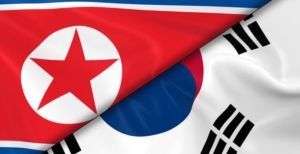By John Ubaldi,
Numerous presidents have faced an international crisis soon after entering the White House. How they handled these crises often defined their approach to foreign affairs.
Now, President Trump might be facing his crisis test on the Korean peninsula.
Ever since North Korea conducted its first successful nuclear test and joined the nuclear nations club, the United States has tried every diplomatic maneuver to prevent the North Korean regime, led by its erratic and unpredictable leader Kim Jong-un, from expanding its nuclear program.
Missile Advances Make North Korea Even More Dangerous
Kim Jong-un is believed to have orchestrated the recent assassination of his half-brother, Kim Jong-nam, in Malaysia. The killing was overshadowed by the launch of various ballistic missiles, including four modified medium-range Scud missiles, into the Sea of Japan.
Pyongyang’s missile firings were designed to prepare North Korea for a strike at U.S. military instillations in the region.
Many experts fear that Pyongyang is edging closer to actually putting a nuclear warhead on a ballistic missile. That would radically change the nuclear equation.
North Korea would be able to launch a nuclear ballistic missile at U.S. instillations in the Far East and potentially target the continental United States.
As a result of the provocation from Pyongyang’s missile launch, the United States accelerated its deployment of the Terminal High-Altitude Area Defense (THAAD) missile system to South Korea. This move bolsters U.S. defenses in the region, but it has also angered the Chinese, who view this deployment as a threat to China.
Tillerson Calls for New Approach in Dealing with North Korea
In his recent travels to the Far East, Secretary of State Rex Tillerson called for a new approach in dealing with North Korea. After 20 years of diplomatic and other approaches to North Korea, the current strategy is clearly not working.
“So we have 20 years of failed approach,” Tillerson said in a March 2017 Reuters article. “That includes a period where the United States has provided $1.35 billion in assistance to North Korea as an encouragement to take a different pathway.”
“In the face of this ever-escalating threat, it is clear that a different approach is required. Part of the purpose of my visit to the region is to exchange views on a new approach,” he added.
Tillerson has pressed the Chinese to do more to rein in North Korea. But Beijing has done very little to curb Kim Jong-un’s dangerous antics.
Although Tillerson called for a new approach, he never spelled out what that approach should be.
Korean Peninsula Has Never Been More Unstable
The current situation on the Korean peninsula has never been more precarious. After the assassination of Kim Jong-nam, who lived in Macao under Beijing’s protection, China terminated its coal purchases from North Korea for the remainder of the year.
Moreover, South Korea is in turmoil following the impeachment of South Korean President Park Geun-hye. She was ousted in the wake of one of the nation’s largest corruption and influence-peddling scandals.
What Are the US Options?
Now, what options are left for the United States? Whatever choices President Trump makes, they all have secondary and tertiary effects.
The United States and the region could just accept the inevitable fact that North Korea will place a nuclear device on a ballistic missile and increase its nuclear inventory. The U.S., South Korea and Japan could then focus on strengthening their missile defense and deterrence.
This course of action is problematic because missile defense systems are imperfect and deterrence is uncertain. Failure in this regard would bring unimaginable costs to the region. It could also force Japan and South Korea to acquire nuclear weapons and unleash an arms race in the Far East.
Another option is to use military force against North Korea. But military force will not ensure that all of the North’s missiles and warheads would be destroyed.
Besides, any strike on North Korea and Pyongyang would unleash a devastating war against South Korea. Seoul is a short distance from North Korean artillery, and thousands of U.S. military personnel and their families are stationed in South Korea. Any conflict there would result in millions of casualties and enormous devastation.
Regime change might be another option, putting in place a more palpable leader in North Korea. But since North Korea is a closed society, this option is more wishful thinking than any serious possible strategy.
All of these potential options and their consequences take us back to diplomacy, which hasn’t worked so far. China is fearful of a regime collapse, which would send thousands of refugees streaming across its border with the North. And China especially does not want a reunified Korea with Seoul as its capital and aligned with the United States.
Returning to Diplomacy Could Be the Best Option
If the United States were to give diplomacy another try, that approach would have to include China working with the U.S. in a difficult attempt to somehow remove the North Korean regime. Washington would have to be careful not to exploit a unification of Korea for its own strategic purposes.
The United States cannot create a unified Korea that is modeled after Austria. Austria became a neutral country after World War II, with no foreign troops stationed on its soil.
All of Trump’s options have ancillary affects. Only time will tell how they play out.


Leave A Comment
You must be logged in to post a comment.